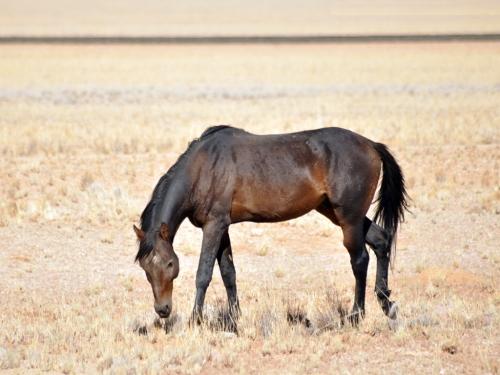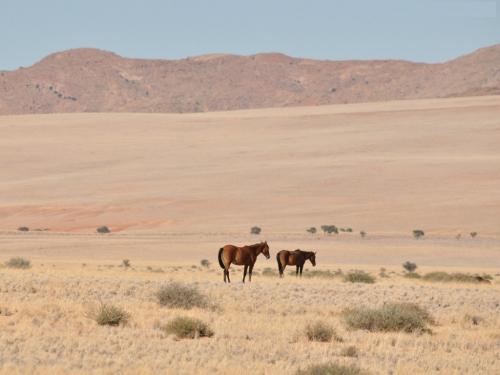Luderitz and Kolmanskop
Visitors en route to Luderitz mostly have to pass through the plains of the Garub – a vast, barren expanse of land that is part of the Namib Desert. In this unlikely territory one can see the wild horses of the Namib – a unique breed of horses that has adapted to survive in isolation in the harshest environment imaginable. Part of the mystery of these feral horses is that no-one is one hundred percent certain of their origin, although there is speculation that their forebears were domesticated and worked in the service of the German cavalry at the time of the occupation. Other theories include horses swimming ashore when a ship was wrecked off the coast at the mouth of the Orange River, and horses escaping from Duwisib Castle, where Baron Hans-Heinrich von Wolf bred horses before his death in the First World War. There have been interventions by humans on behalf of the horses in times of severe drought and a water hole has now been established with a hide overlooking the site. Visitors are often lucky enough to see other indigenous wildlife drinking water, as the horses share the area with ostriches, gemsbok and springbok as well as the numerous birds of the plains.



The German village of Luderitz itself, huddled on the coast of the Namib Desert, is a surreal relic of German colonial rule. The village was founded by the Bremen merchant Adolf Luderitz who, being a tobacco merchant, was interested in planting tobacco in Africa. Speculating on mineral deposits in the area, Luderitz was responsible for the establishment of a colonial territory in Africa, and persuaded the German Chancellor Bismarck to place “Southwest Africa” under German control in 1884. Within the town, you can find fine examples of German architecture, including the Felsenkirche (Rock Church). This Lutheran church was built in 1911 with donations received from all over Germany. The church is adorned with exquisite stained glass windows, which came from the finest Bremen Company artists of the time, and are actually all that remains out of the vast number of such windows created and installed by the company, but which were subsequently destroyed in the demolition of churches throughout Germany.
In the near vicinity of Luderitz lies the ghost town of Kolmanskop. Once a boomtown, this diamond mining center is slowly being reclaimed by the sands of the Namib. History has it that on 14 April 1908 a railway worker by the name of Zacharias Lewala, who was working on the railway line between Luderitz and Aus, found a “shiny stone” lying on the sand and showed it to his supervisor, the railway inspector August Stauch, who recognized it as a diamond. Stauch obtained a prospector’s license and as soon as it was confirmed that the stone was indeed a diamond, the rush to Kolmanskop was on. It turned out that the stone found by Zacharias Lewala was far from being an isolated example, and diamonds lay on the surface of the ground in great numbers. It was apparently common for prospectors to lie on their bellies and slowly crawl across the sand, picking up diamonds by the dozen. Fuelled by the wealth that lay upon the sand, the village quickly grew to include a hospital (which housed the first x-ray unit in the southern hemisphere), a school, casino, theatre, ballroom, gymnasium, skittle-alley and even an ice factory. Mansions were built for the senior mine officials in the midst of the sand dunes and Kolmanskop became one of the wealthiest communities in Africa at that time. Of course water was in short supply and some had to be shipped from Cape Town to Luderitz and then carried by mule to Kolmanskop. The balance of the water came via a pipeline from Elizabeth Bay and even from a small desalination plant. Every morning an ice block and fresh water was delivered to each of the houses, bringing some comfort in the heat of the desert. At its peak, some seven hundred families resided in Kolmanskop. It wasn’t long after the First World War, though, that diamond sales began to drop, and with the discovery of rich diamond fields to the south, near the mouth of the Orange River, prospectors began to leave Kolmanskop. The last residents left in 1956 although mining had stopped some years earlier, and the desert soon began to reclaim its own. Given a second chance by tourism in more recent years, visitors can tour the town and are also given the opportunity to purchase a diamond found in the local area.

Over the past few years, Luderitz has also become well known as a kite-surfing destination, and plays host to the annual “Luderitz Speed Challenge”. A shot video of this event can be found here: http://www.youtube.com/watch?v=-9_AYXsGq3g



The German village of Luderitz itself, huddled on the coast of the Namib Desert, is a surreal relic of German colonial rule. The village was founded by the Bremen merchant Adolf Luderitz who, being a tobacco merchant, was interested in planting tobacco in Africa. Speculating on mineral deposits in the area, Luderitz was responsible for the establishment of a colonial territory in Africa, and persuaded the German Chancellor Bismarck to place “Southwest Africa” under German control in 1884. Within the town, you can find fine examples of German architecture, including the Felsenkirche (Rock Church). This Lutheran church was built in 1911 with donations received from all over Germany. The church is adorned with exquisite stained glass windows, which came from the finest Bremen Company artists of the time, and are actually all that remains out of the vast number of such windows created and installed by the company, but which were subsequently destroyed in the demolition of churches throughout Germany.
In the near vicinity of Luderitz lies the ghost town of Kolmanskop. Once a boomtown, this diamond mining center is slowly being reclaimed by the sands of the Namib. History has it that on 14 April 1908 a railway worker by the name of Zacharias Lewala, who was working on the railway line between Luderitz and Aus, found a “shiny stone” lying on the sand and showed it to his supervisor, the railway inspector August Stauch, who recognized it as a diamond. Stauch obtained a prospector’s license and as soon as it was confirmed that the stone was indeed a diamond, the rush to Kolmanskop was on. It turned out that the stone found by Zacharias Lewala was far from being an isolated example, and diamonds lay on the surface of the ground in great numbers. It was apparently common for prospectors to lie on their bellies and slowly crawl across the sand, picking up diamonds by the dozen. Fuelled by the wealth that lay upon the sand, the village quickly grew to include a hospital (which housed the first x-ray unit in the southern hemisphere), a school, casino, theatre, ballroom, gymnasium, skittle-alley and even an ice factory. Mansions were built for the senior mine officials in the midst of the sand dunes and Kolmanskop became one of the wealthiest communities in Africa at that time. Of course water was in short supply and some had to be shipped from Cape Town to Luderitz and then carried by mule to Kolmanskop. The balance of the water came via a pipeline from Elizabeth Bay and even from a small desalination plant. Every morning an ice block and fresh water was delivered to each of the houses, bringing some comfort in the heat of the desert. At its peak, some seven hundred families resided in Kolmanskop. It wasn’t long after the First World War, though, that diamond sales began to drop, and with the discovery of rich diamond fields to the south, near the mouth of the Orange River, prospectors began to leave Kolmanskop. The last residents left in 1956 although mining had stopped some years earlier, and the desert soon began to reclaim its own. Given a second chance by tourism in more recent years, visitors can tour the town and are also given the opportunity to purchase a diamond found in the local area.
Over the past few years, Luderitz has also become well known as a kite-surfing destination, and plays host to the annual “Luderitz Speed Challenge”. A shot video of this event can be found here: http://www.youtube.com/watch?v=-9_AYXsGq3g
G & G